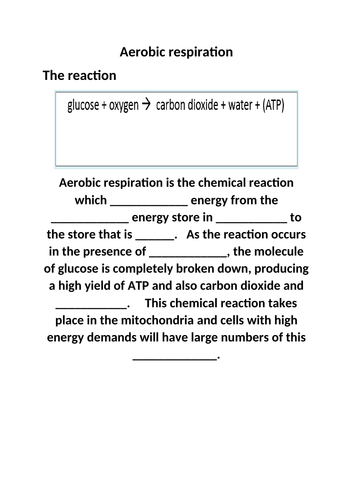


A resourced lesson which looks at the chemical reaction that is aerobic respiration and ensures that students can apply their knowledge to application questions which challenge them to make links to related topics. The lesson includes an engaging lesson presentation (27 slides) and an associated worksheet containing questions.
The lesson begins by challenging the students to recognise a definition for breathing and a definition for respiration. This is aimed at helping them to understand that these are different processes as this is a common misconception made by students. Moving forwards, key details about aerobic respiration are introduced to the students through a range of tasks which include competitions to maintain engagement. Time is taken to ensure that students become familiar with ATP and understand that this is the energy store which will be broken down to release energy for the activities that occur in a living organism. The remainder of the lesson challenges the students to take their new found knowledge of aerobic respiration and apply it to range of unfamiliar situations such as explaining why a root hair cell would have such a large number of mitochondria.
There are regular progress checks throughout the lesson to allow the students to check on their understanding. As always, the lesson finishes with a slide containing advanced terminology so that students who have aspirations to take A-level Biology can extend and deepen their knowledge
Get this resource as part of a bundle and save up to 33%
A bundle is a package of resources grouped together to teach a particular topic, or a series of lessons, in one place.
Topic B1: Cell-level systems (OCR Gateway A GCSE Biology)
This bundle of 10 lessons covers the majority of the content in Topic B1 (Cell-level systems) of the OCR Gateway A GCSE Biology specification. The topics covered within these lessons include: Plant and animal cells Bacterial cells Light microscopy Electron microscopy DNA Transcription and translation Enzymes Enzyme actions Aerobic respiration Anaerobic respiration Photosynthesis Limiting factors All of these lesson presentations and accompanying resources are detailed and engaging and contain regular progress checks to allow the students to constantly assess their understanding.
Topic B1: Cell Level Systems (OCR Gateway A GCSE Combined Science)
This bundle of 9 lessons covers the majority of the content in Topic B1 of the OCR Gateway A GCSE Combined Science specification. The topics covered within these lessons include: Animal and plant cells Prokaryotic cells Light and electron microscopy DNA Enzymes Enzyme activity Aerobic respiration Anaerobic respiration Photosynthesis All of these lesson presentations and accompanying resources are detailed and engaging and contain regular progress checks to allow the students to constantly assess their understanding. It is estimated that this bundle would cover about 6 week's worth of lessons.
Topic B4: Bioenergetics (AQA Trilogy GCSE Combined Science & GCSE Biology)
This bundle of 4 lessons covers the majority of the content in Topic B4 (Bioenergetics) of the AQA Trilogy GCSE Combined Science & GCSE Biology specifications. The topics covered within these lessons include: Photosynthesis Uses of glucose from photosynthesis Limiting factors Aerobic respiration Anaerobic respiration Response to exercise All of these lesson presentations and accompanying resources are detailed and engaging and contain regular progress checks to allow the students to constantly assess their understanding.
Topic B8: Exchange and transport in animals (Edexcel GCSE Combined Science)
This bundle of 7 lessons covers the majority of the content in Topic B8 (Exchange and transport in animals) of the Edexcel GCSE Combined Science specification. The topics covered within these lessons include: The need to transport substances Surface to volume ratio Gas exchange at the alveoli The structure of blood and its function The structure of blood vessels The structure of the heart Aerobic and anaerobic respiration All of these lesson presentations and accompanying resources are detailed and engaging and contain regular progress checks to allow the students to constantly assess their understanding.
Something went wrong, please try again later.
This resource hasn't been reviewed yet
To ensure quality for our reviews, only customers who have purchased this resource can review it
Report this resourceto let us know if it violates our terms and conditions.
Our customer service team will review your report and will be in touch.